Prediction of B20 Storage Tank Precipitate Removal Based on Biodiesel Monoglyceride Content
Abstract
:1. Introduction
2. Materials and Methods
2.1. Fuel Preparation and Analysis
2.2. Precipitation Test
2.3. Calculation of Estimated Sludge of B20 and Schedule for Sludge Removal
3. Results
3.1. Properties and Modified Monoglyceride Content of Biodiesel
3.2. Result of Precipitation Test
4. Discussion
5. Conclusions
Author Contributions
Funding
Institutional Review Board Statement
Informed Consent Statement
Data Availability Statement
Acknowledgments
Conflicts of Interest
References
- Knothe, G.; Steidley, K.R. Kinematic viscosity of biodiesel fuel components and related compounds. Influence of compound structure and comparison to petrodiesel fuel components. Fuel 2005, 84, 1059–1065. [Google Scholar] [CrossRef]
- Mittlebach, M.; Remschmidt, C. Biodiesel: The Comprehensive Handbook; Boersedruck Ges. MBH: Viena, Austria, 2004. [Google Scholar]
- Knothe, G.; Van Gerpen, J.H.; Krahl, J. The Biodiesel Handbook; AOCS Press: Champaign, IL, USA, 2005. [Google Scholar]
- Hoekman, S.K.; Broch, A.; Robbins, C.; Ceniceros, E.; Natarajan, M. Review of biodiesel composition, properties, and specifications. Renew. Sustain. Energy Rev. 2012, 16, 143–169. [Google Scholar] [CrossRef]
- Dunn, R.O. Effects of minor constituents on cold flow properties and performance of biodiesel. Prog. Energy Combust. Sci. 2009, 35, 481–489. [Google Scholar] [CrossRef]
- Thangamani, S.; Sundaresan, S.N.; Kannappan, S.S.; Barawkar, V.T.; Jeyaseelan, T. Impact of biodiesel and diesel blends on the fuel filter: A combined experimental and simulation study. Energy 2021, 227, 120526. [Google Scholar] [CrossRef]
- Chupka, G.M.; Fouts, L.; McCormick, R.L. Effect of low-level impurities on low-temperature performance properties of biodiesel. Energy Environ. Sci. 2012, 5, 8734–8742. [Google Scholar] [CrossRef]
- Na-Ranong, D.; Kitchaiya, P. Precipitation above cloud point in palm oil based biodiesel during production and storage. Fuel 2014, 122, 287–293. [Google Scholar] [CrossRef]
- Tang, H.; Salley, S.O.; Ng, K.S. Fuel properties and precipitate formation at low temperature in soy-, cottonseed-, and poultry fat-based biodiesel blends. Fuel 2008, 87, 3006–3017. [Google Scholar] [CrossRef]
- Tang, H.; De Guzman, R.C.; Salley, S.O.; Simon Ng, K.Y. Formation of insolubles in palm oil-, yellow grease-, and soybean oil-based biodiesel blends after cold soaking at 4 °C. J. Am. Oil Chem. Soc. 2008, 85, 1173–1182. [Google Scholar] [CrossRef]
- Joshi, R.M.; Pegg, M.J. Flow properties of biodiesel fuel blends at low temperatures. Fuel 2007, 86, 143–151. [Google Scholar] [CrossRef]
- Soriano, N.U.; Migo, V.P.; Matsumura, M. Ozonized vegetable oil as pour point depressant for neat biodiesel. Fuel 2006, 85, 25–31. [Google Scholar] [CrossRef]
- Soriano, N.U.; Migo, V.P.; Sato, K.; Matsumura, M. Crystallization behaviour of neat biodiesel and biodiesel treated with ozonized vegetable oil. Eur. J. Lipid Sci. 2005, 107, 689–696. [Google Scholar] [CrossRef]
- Alleman, T.L.; McCormick, R.L.; Christensen, E.D.; Fioroni, G.; Moriarty, K.; Yanowitz, J. 2016 Biodiesel Handling and Use Guide; US Department of Energy: Washington, DC, USA, 2016. [Google Scholar]
- Plata, V.; Gauthier-Maradei, P.; Kafarov, V. Influence of minor components on precipitate formation and filterability of palm oil biodiesel. Fuel 2015, 144, 130–136. [Google Scholar] [CrossRef]
- Alves-Fortunato, M.; Ayoub, E.; Bacha, K.; Mouret, A.; Dalmazzone, C. Fatty Acids Methyl Esters (FAME) autoxidation: New insights on insoluble deposit formation process in biofuels. Fuel 2020, 268, 117074. [Google Scholar] [CrossRef]
- ASTM D 7501-12a; Standard Test Method for Determination of Fuel Filter Blocking Potential of Biodiesel (B100) Blend Stock by Cold Soak Filtration Test (CSFT); ASTM International: Philadelphia, PA, USA, 2012.
- Lin, H.; Haagenson, D.M.; Wiesenborn, D.P.; Pryor, S.W.; Brudvik, R. Effect of Trace Contaminants on Cold Soak Filterability of Canola Biodiesel. In 2010 Pittsburgh, Pennsylvania, June 20–June 23, 2010; American Society of Agricultural and Biological Engineers: St. Joseph, MI, USA, 2010; Volume 90, pp. 1771–1777. [Google Scholar] [CrossRef]
- ASTM D 2068-10Determination of Filter Blocking Tendency (FBT), ASTM International: Philadelphia, PA, USA, 2010.
- IP 3872939444Determination of Filter Blocking Tendency, Energy Institute Publication: London, UK, 2017.
- Girry, I.P.; Paryanto, I.; Prakoso, T.; Gozan, M. Effect of monopalmitin content and temperature on precipitation rate in biodiesel-petroleum diesel blends. In E3S Web of Conferences—CSSPO; EDP Sciences: Les Ulis, France, 2018; Volume 52, p. 00021. [Google Scholar]
- Ghaizani, M.A.; Abdurrosyid, I.; Paryanto, I.; Gozan, M. Monostearin effects on the formation of precipitate in palm oil biodiesel and petroleum diesel blends with various storage temperature. In E3S Web of Conferences—CSSPO; EDP Sciences: Les Ulis, France, 2018; Volume 52, p. 00026. [Google Scholar]
- Paryanto, I.; Prakoso, T.; Susanto, H.B.; Gozan, M. The Effect of Outdoor Temperature Conditions and Monoglyceride Content on the Precipitate Formation of Biodiesel-Petrodiesel Blended Fuel (BXX). Evergreen 2019, 6, 59–64. [Google Scholar] [CrossRef]
- Paryanto, I.; Prakoso, T.; Suyono, E.A.; Gozan, M. Determination of the upper limit of monoglyceride content in biodiesel for B30 implementation based on the measurement of the precipitate in a Biodiesel–Petrodiesel fuel blend (BXX). Fuel 2019, 258, 116104. [Google Scholar] [CrossRef]
- Mansur, D.; Fitriady, M.A.; Setiapraja, H.; Paryanto, I.; Haspriyanti, N.; Dela, N.; Gozan, M. Precipitation Study of B30 Blended from FAME and/or HVO and Petro Diesel Fuel. In SAE Technical Paper Series; SAE International: Warrendale, PA, USA, 2019. [Google Scholar]
- Paryanto, I.; Rismana, E.; Arbianto, A.; Prakoso, T.; Gozan, M. The Effect of Fuel Filter Pore Size on B20 Fuel Filter Clogging at Low-Temperature Condition. IOP Conf. Ser. Earth Environ. Sci. 2020, 520, 012002. [Google Scholar] [CrossRef]
- Economic Research Institute for ASEAN and East Asia (ERIA). Study of Renewable Energy Potential and Its Effective Usage in East Asia Summit Countries; ERIA Project Report 2017 No.17; Economic Research Institute for ASEAN and East Asia (ERIA): Jakarta, Indonesia, 2017. [Google Scholar]
- Ministry of Energy and Mineral Resources (MEMR), Indonesia. MEMR Regulation No. 12/2015 about Supply, Utilization and Commerce of Biofuel; Ministry of Energy and Mineral Resources (MEMR): Jakarta, Indonesia, 2015.
- Ministry of Energy and Mineral Resources (MEMR), Indonesia. Report of Assessment and Testing of B20 Utilization (B20 Road Test); Ministry of Energy and Mineral Resources (MEMR): Jakarta, Indonesia, 2015.
- SNI 7182-2015Indonesia National Biodiesel Standard, Badan Standardisasi Nasional (BSN): Jakarta, Indonesia, 2015.
- ASTM D 6584-00Determination of Free and Total Glycerin in B-100 Biodiesel Methyl Esters by Gas Chromatography, ASTM International: Philadelphia, PA, USA, 2000.


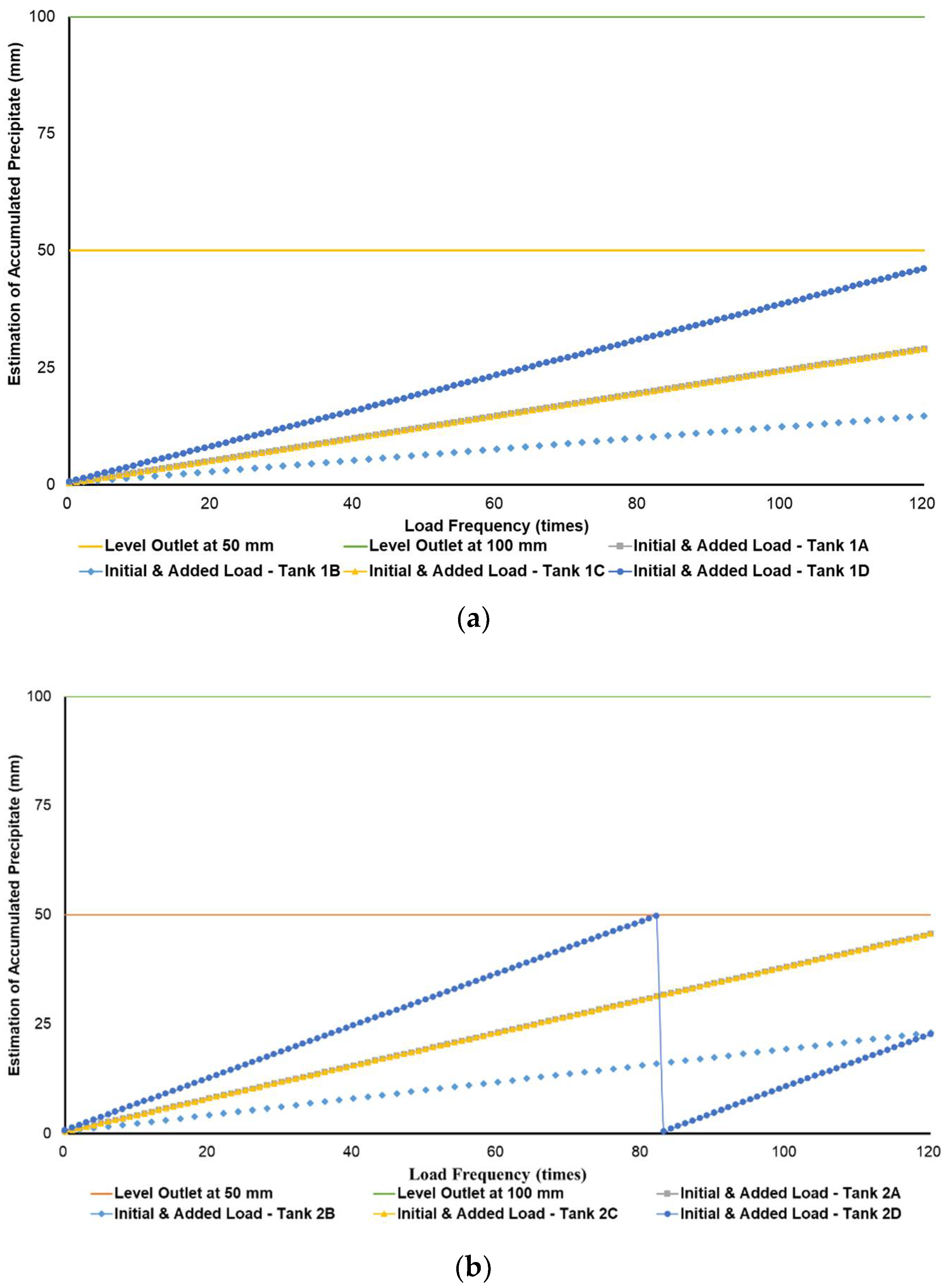
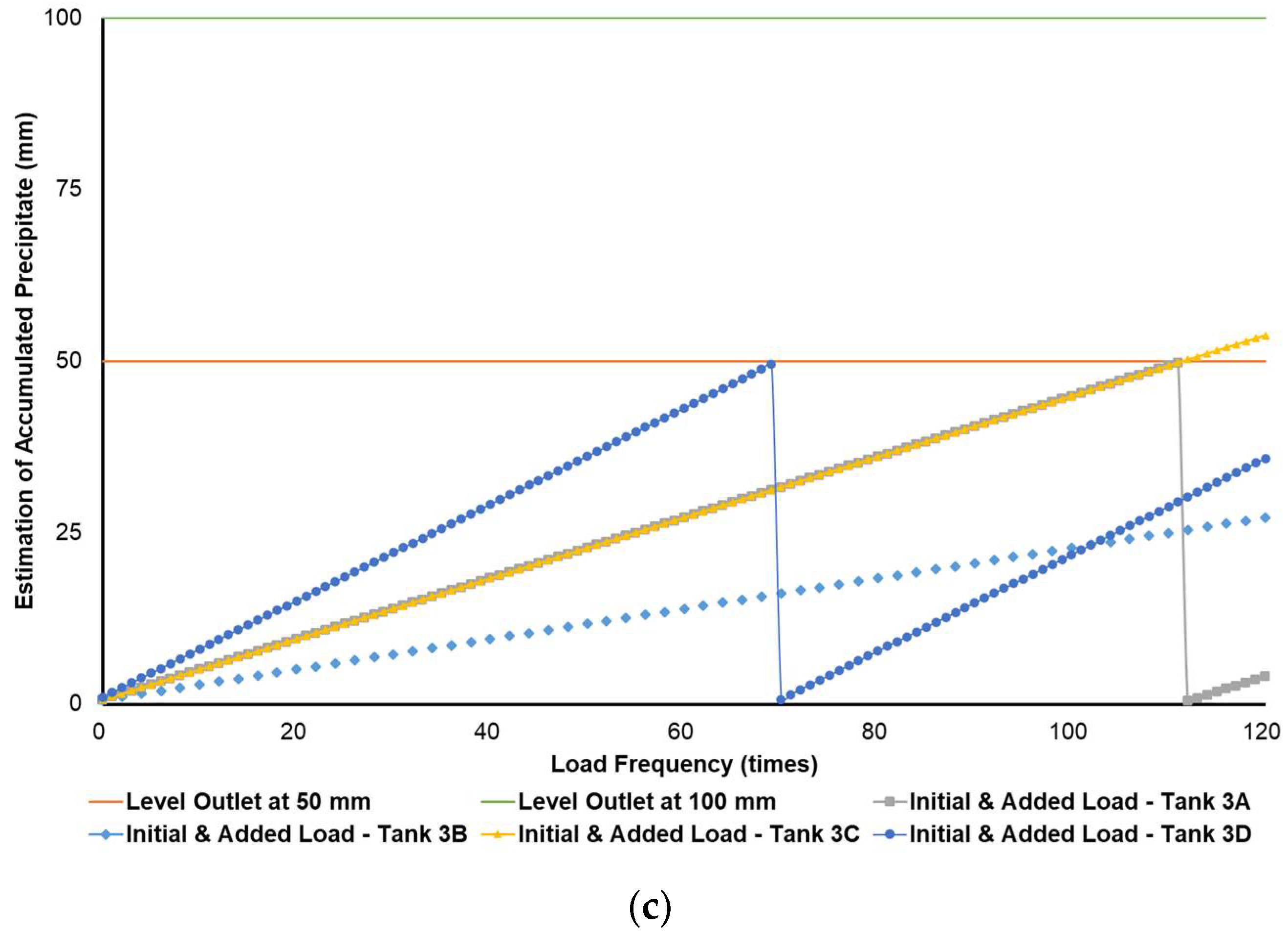
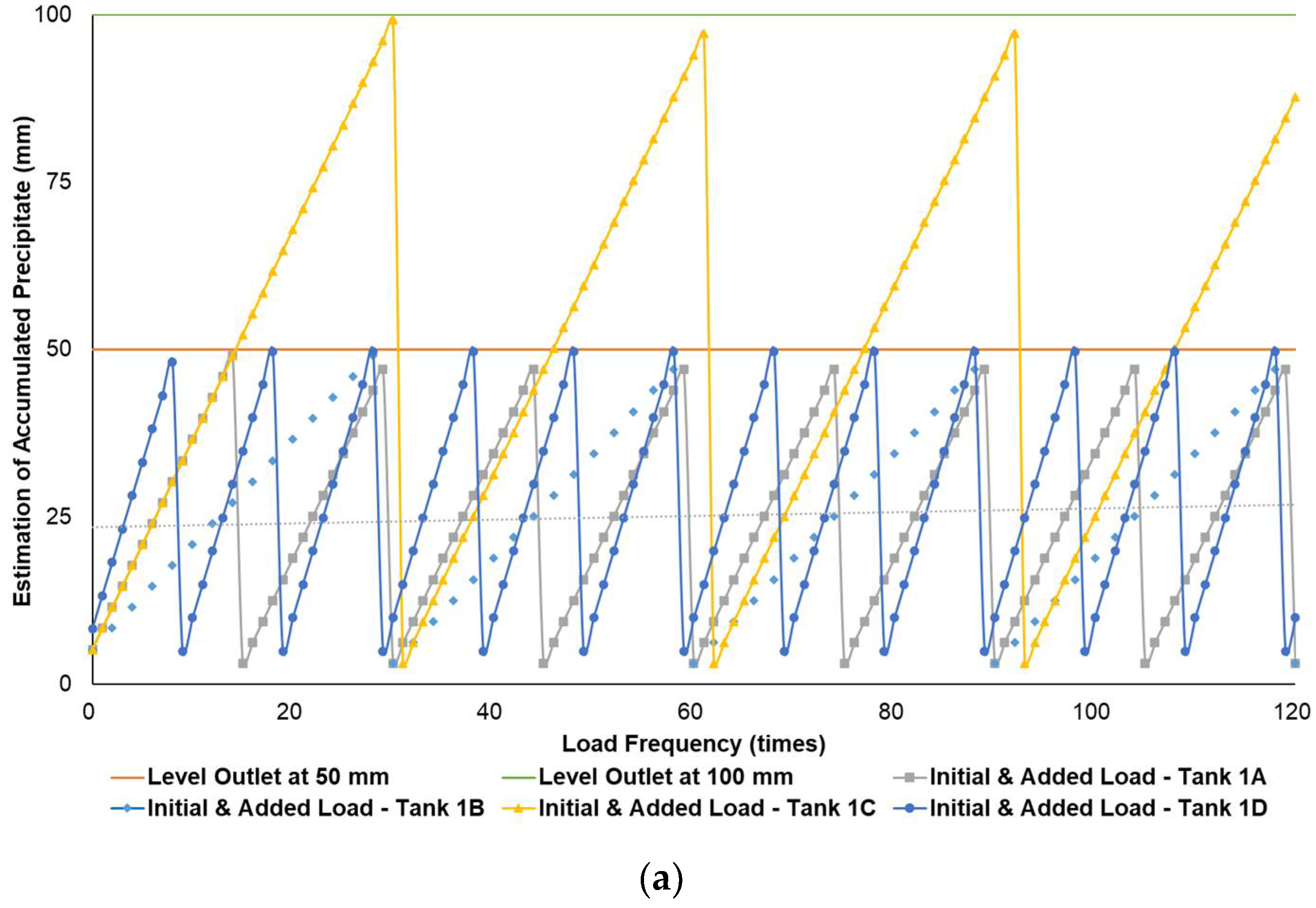
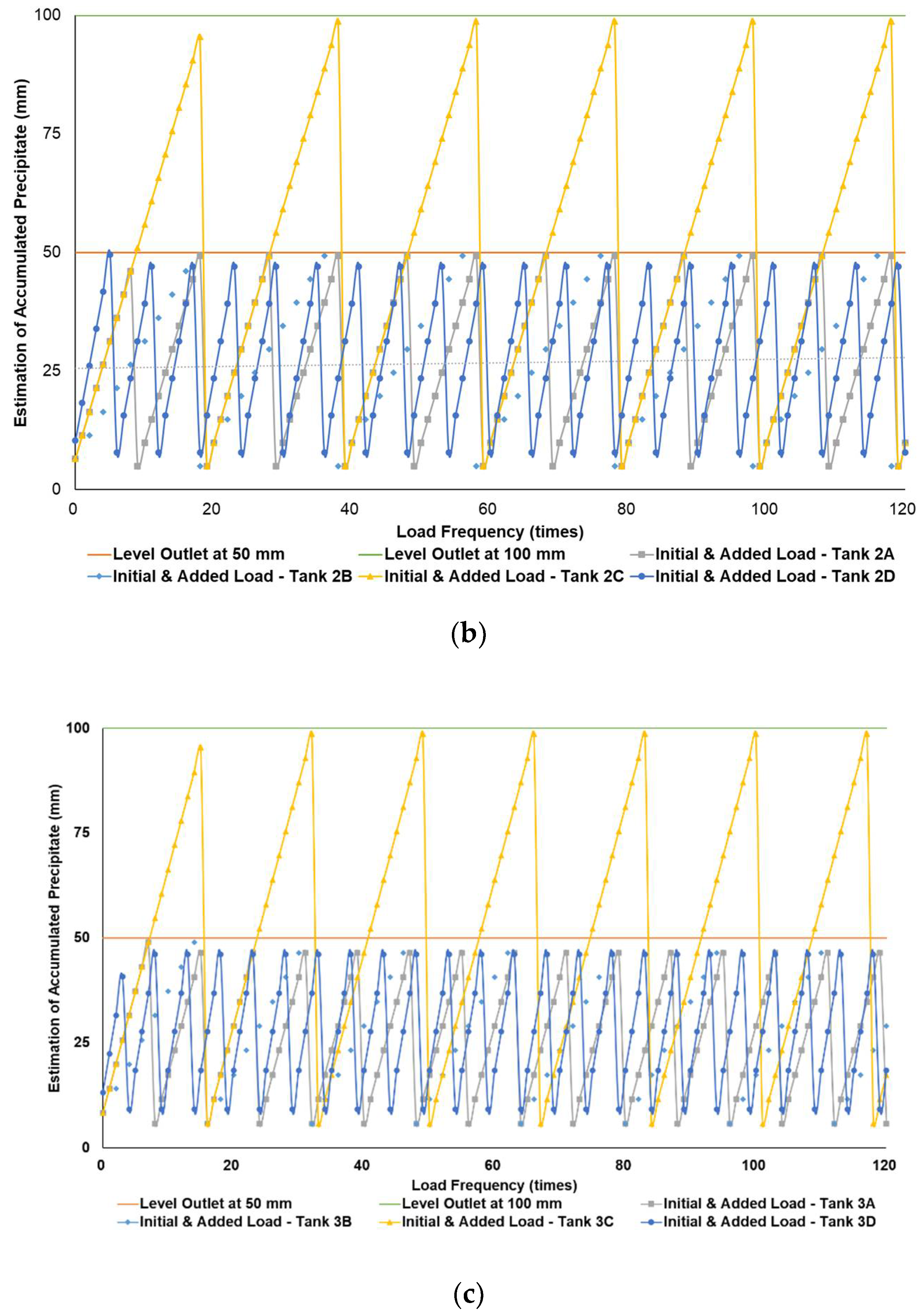
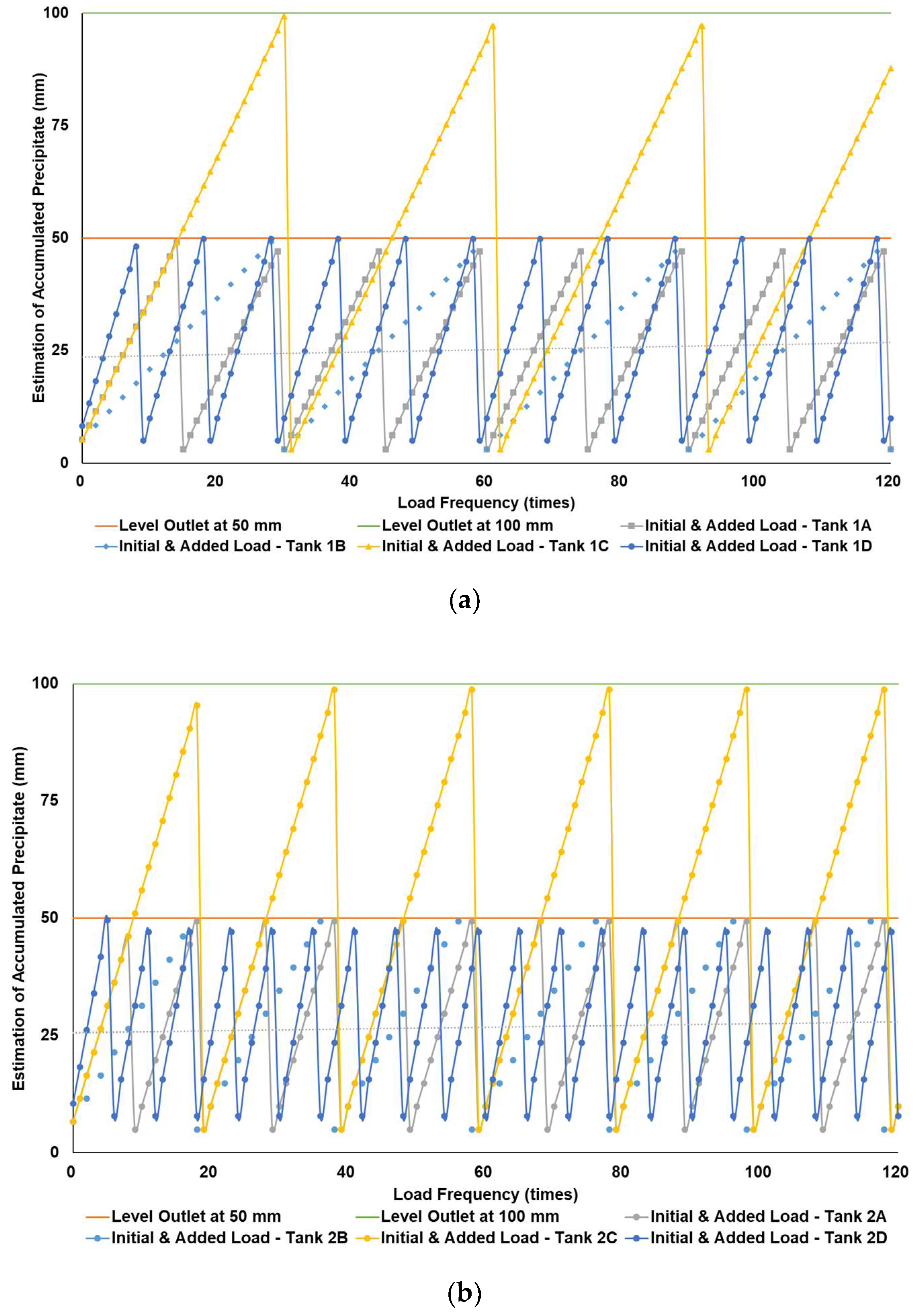
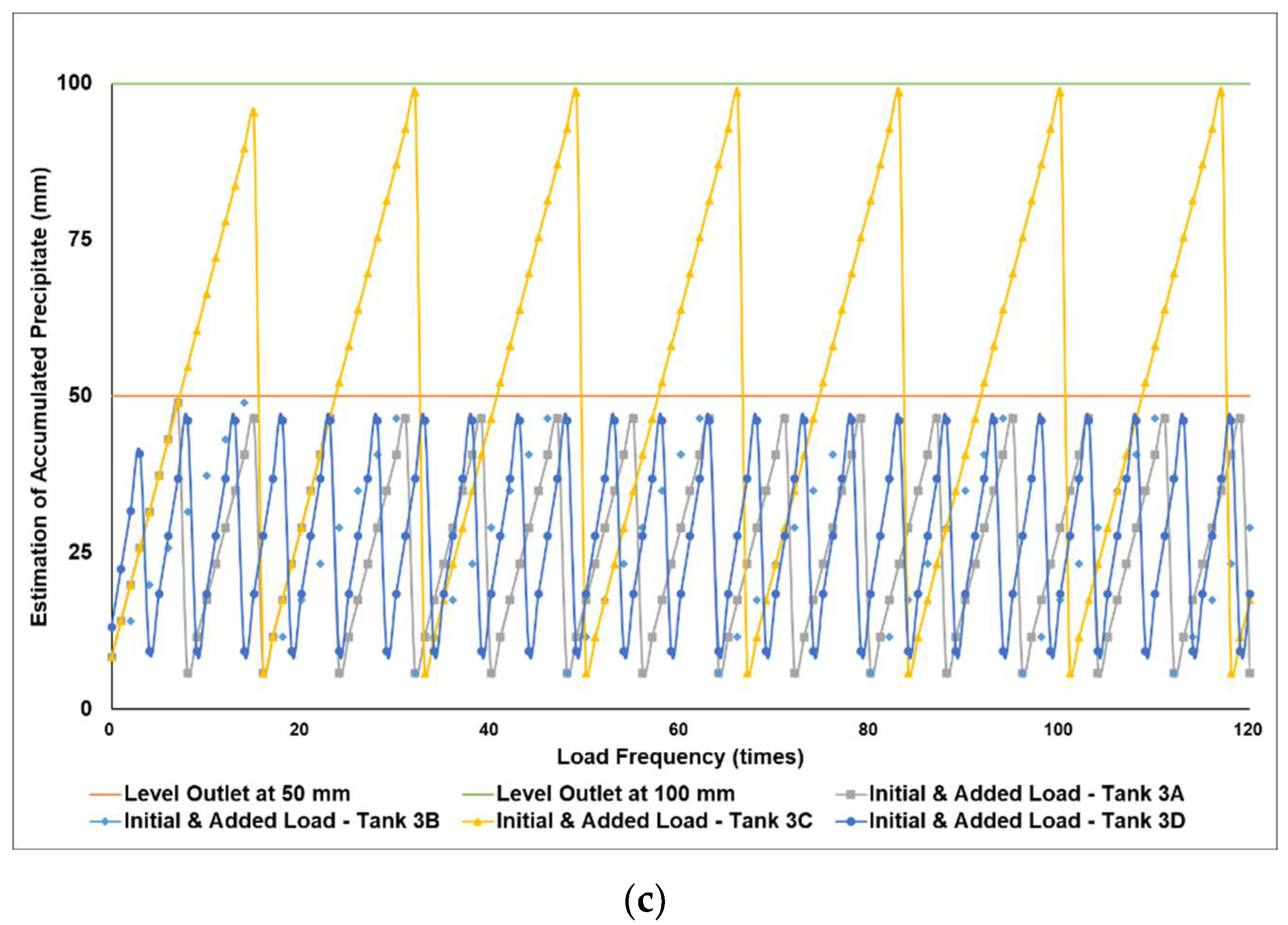
| No. | Fuel Storage Tank | Capacity (m3) | Fuel Loading Volume VL (m3) | Fuel Loading Frequency f (days) | Tank Capacity (m3) | Tank Dimension (mm) | Ratio H/D | Discharge/Outlet Pipe Height (h) (mm) | ||
|---|---|---|---|---|---|---|---|---|---|---|
| Total (VT) | Min Stock (Vmin) | Diameter (D) | Height (H) | |||||||
| 1 | 1A | 50 | 20 | 30 | 2 | 55.6 | 4136 | 4136 | 1 | 50 |
| 2 | 1B | 50 | 20 | 30 | 4 | 55.6 | 4136 | 4136 | 1 | 50 |
| 3 | 1C | 50 | 20 | 30 | 4 | 55.6 | 4136 | 4136 | 1 | 100 |
| 4 | 1D | 50 | 20 | 30 | 4 | 55.6 | 3283 | 6566 | 2 | 50 |
| 5 | 2A | 100 | 25 | 75 | 3 | 111.1 | 5211 | 5211 | 1 | 50 |
| 6 | 2B | 100 | 25 | 75 | 6 | 111.1 | 5211 | 5211 | 1 | 50 |
| 7 | 2C | 100 | 25 | 75 | 6 | 111.1 | 5211 | 5211 | 1 | 100 |
| 8 | 2D | 100 | 25 | 75 | 6 | 111.1 | 4136 | 8273 | 2 | 50 |
| 9 | 3A | 200 | 60 | 140 | 7 | 222.2 | 6566 | 6566 | 1 | 50 |
| 10 | 3B | 200 | 60 | 140 | 14 | 222.2 | 6566 | 6566 | 1 | 50 |
| 11 | 3C | 200 | 60 | 140 | 14 | 222.2 | 6566 | 6566 | 1 | 100 |
| 12 | 3D | 200 | 60 | 140 | 14 | 222.2 | 5211 | 10,423 | 2 | 50 |
| No. | Parameter | B100 | Petrodiesel | B20 | Limit | Methods |
|---|---|---|---|---|---|---|
| 1 | Density at 15 °C (kg/m3) | 855–857 | 840–844 | 841–848 | 815–860 | ASTM D4052 |
| 2 | Kinematic viscosity at 40 °C (mm2/s) | 4.51 | 2.6 | 2.98 | 2.0–4.5 | ASTM D445 |
| 3 | Cloud point (°C) | 15–16 | 1.7 | 9.7 | 18 max | ASTM D2500 |
| 4 | Ester (% mass) | 98.7–99.5 | <0 | 20.1 | -- | ASTM D7806 |
| 5 | Acid number (mg KOH/g) | 0.34 | n.a. | 0.089 | 0.6 | ASTM D664 |
| 6 | Oxidation stability (hours) | 601 | n.a. | 36.21–36.87 | 35 | EN 15751 |
| 7 | Water content (%-vol) | >500 | n.a. | 249.87 | 500 max | ASTM D6304 |
| 8 | Sediment content (% mass) | <0 | n.a. | <0 | 0.01 max | ASTM D473 |
| 9 | Sulfur (% mass) | n.a. | 0.106 | n.a. | 0.25 | ASTM D4294 |
| 10 | Free glycerol (% mass) | 0.003–0.006 | n.a. | n.a. | 0.02 | ASTM D6584 |
| 11 | Total glycerol (% mass) | 0.100–0.128 | n.a. | n.a. | 0.34 | ASTM D6584 |
| 12 | Mono-glyceride (% mass) | 0.179–0.369 | n.a. | n.a. | 0.8 | ASTM D6584 |
| No. | Biodiesel | Added Monopalmitin, mg/L B100 | Monoglyceride %-Mass | Monopalmitin %-Mass | Monoolein %-Mass | Monostearin %-Mass |
|---|---|---|---|---|---|---|
| 1 | B100–MG initial | - | 0.179 | 0.094 | 0.070 | 0.015 |
| 2 | B100–MG 0.4 | 2038.76 | 0.437 | 0.348 | 0.071 | 0.019 |
| 3 | B100–MG 0.6 | 3842.97 | 0.623 | 0.533 | 0.071 | 0.019 |
| No. | Soaking Temperatures (°C) | Sample B20 Blended from B100 with 0.179% MG | Ratio = e:d | ||
|---|---|---|---|---|---|
| The Precipitate from Precipitation Test, g/L | Estimated Accumulated Precipitate, g/L | ||||
| In 100 mL | In 2 Liters | ||||
| a | b | c | d | e | f |
| 1 | 24–30 (room temperatures) | 0.012 | 0.012 | 0.016 | 1.3 |
| 2 | 25 | 0.013 | 0.014 | 0.018 | 1.3 |
| 3 | 20 | 0.013 | 0.012 | 0.016 | 1.3 |
| 4 | 15 | 0.015 | 0.015 | 0.021 | 1.4 |
| No. | Soaking Temperatures (°C) | Sample B20 blended from B100 with 0.437% MG | Ratio = e:d | ||
| Precipitate from Precipitation Test, g/L | Estimated Accumulated Precipitate, g/L | ||||
| in 100 mL | in 2 Liters | ||||
| a | b | c | d | e | f |
| 1 | 24–30 (room temperatures) | 0.021 | 0.016 | 0.019 | 1.2 |
| 2 | 25 | 0.070 | 0.031 | 0.090 | 2.9 |
| 3 | 20 | 0.120 | 0.054 | 0.187 | 3.5 |
| 4 | 15 | 0.162 | 0.145 | 0.368 | 2.5 |
| No. | Soaking Temperatures (°C) | Sample B20 blended from B100 with 0.623% MG | Ratio = e:d | ||
| Precipitate from Precipitation Test, g/L | Estimated Accumulated Precipitate, g/L | ||||
| in 100 mL | in 2 Liters | ||||
| a | b | c | d | e | f |
| 1 | 24–30 (room temperatures) | 0.102 | 0.120 | 0.850 | 7.1 |
| 2 | 25 | 0.148 | 0.125 | 1.180 | 9.4 |
| 3 | 20 | 0.262 | 0.285 | 2.150 | 7.5 |
| 4 | 15 | 0.308 | 0.305 | 2.170 | 7.1 |
| No. | Soaking Temperatures (°C) | Sample B20 (Biosolar) from Market (Fuel Station) | Ratio = e:d | ||
| Precipitate from Precipitation Test, g/L | Estimated Accumulated Precipitate, g/L | ||||
| in 100 mL | in 2 Liters | ||||
| a | b | c | d | e | f |
| 1 | 24–30 (room temperatures) | 0.099 | 0.078 | 0.794 | 10.2 |
| 2 | 25 | 0.120 | 0.138 | 1.180 | 8.6 |
| 3 | 20 | 0.234 | 0.246 | 1.981 | 8.1 |
| 4 | 15 | 0.218 | 0.258 | 2.201 | 8.5 |
Publisher’s Note: MDPI stays neutral with regard to jurisdictional claims in published maps and institutional affiliations. |
© 2022 by the authors. Licensee MDPI, Basel, Switzerland. This article is an open access article distributed under the terms and conditions of the Creative Commons Attribution (CC BY) license (https://creativecommons.org/licenses/by/4.0/).
Share and Cite
Gozan, M.; Paryanto, I.; Darmawan, M.A.; Sahlan, M.; Hermansyah, H.; Rismana, E.; Arbianto, A.D.; Prakoso, T.; Aroua, M.K.; Cognet, P. Prediction of B20 Storage Tank Precipitate Removal Based on Biodiesel Monoglyceride Content. ChemEngineering 2022, 6, 7. https://doi.org/10.3390/chemengineering6010007
Gozan M, Paryanto I, Darmawan MA, Sahlan M, Hermansyah H, Rismana E, Arbianto AD, Prakoso T, Aroua MK, Cognet P. Prediction of B20 Storage Tank Precipitate Removal Based on Biodiesel Monoglyceride Content. ChemEngineering. 2022; 6(1):7. https://doi.org/10.3390/chemengineering6010007
Chicago/Turabian StyleGozan, Misri, Imam Paryanto, Muhammad Arif Darmawan, Muhammad Sahlan, Heri Hermansyah, Eriawan Rismana, Alfan Danny Arbianto, Tirto Prakoso, Mohamed Kheireddine Aroua, and Patrick Cognet. 2022. "Prediction of B20 Storage Tank Precipitate Removal Based on Biodiesel Monoglyceride Content" ChemEngineering 6, no. 1: 7. https://doi.org/10.3390/chemengineering6010007
APA StyleGozan, M., Paryanto, I., Darmawan, M. A., Sahlan, M., Hermansyah, H., Rismana, E., Arbianto, A. D., Prakoso, T., Aroua, M. K., & Cognet, P. (2022). Prediction of B20 Storage Tank Precipitate Removal Based on Biodiesel Monoglyceride Content. ChemEngineering, 6(1), 7. https://doi.org/10.3390/chemengineering6010007






